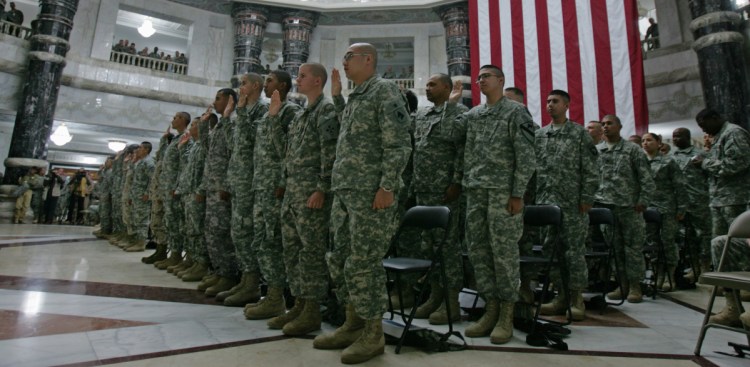In 1917 the United States was going through one of its great periods of change and upheaval – and the Army sent to fight in World War I reflected that.
“You could not imagine a more extraordinary gathering than this American army,” a French soldier remarked. “There is a bit of everything, Greeks, Italians, Turks, Indians, Spanish, also a sizable number of boches (German soldiers). Truthfully, almost half of the officers have German origins. This doesn’t seem to bother them … Among the Americans are sons of emigrated Frenchmen and sons of emigrated boche. I asked one son of a Frenchman if these Germans were coming willingly to fight their brothers and cousins, he squarely answered me: ‘Yes!’ ”
Countries around the globe at the time were losing citizens by droves, some because of conflict or lack of opportunity, others because of ethnic, religious and political divisions. They faced trouble here, too, as fear of immigrants rose among native-born Americans. But when it came time to fight, the U.S. Army embraced them.
To foreign countries consumed by national identity, that just didn’t make sense; the World War I fighting force showed why the United States was, and remains, exceptional.
The early 20th century was a time of immigration. From 1901 to 1920, nearly 14.5 million immigrants entered a country of 76 million.
When the U.S. needed fighters for World War I, it sought out these new Americans. Military service, as always in our history, offered immigrants a path to citizenship and a chance to show appreciation for their new home.
The 1917 U.S. Army featured about 500,000 immigrants from 46 countries. Immigrants would make up about one-fifth of the fighting force, including 13 Medal of Honor recipients.
Initially, the military adopted a policy of forced assimilation, but as Nancy Gentile Ford points out in her book “Americans All!: Foreign-born soldiers in World War I,” they ran into trouble melding the military’s traditions with those of the immigrants.
To its credit, the military learned from social reformers and ethnic community leaders who were then working in American cities to settle immigrants. Officers found that patriotism and loyalty to the United States could coexist with the cultural traditions the immigrants held so dear.
Thus, a fighting force was formed with not only native-born American soldiers but also Irish, Italian, Polish, Ukrainian, Russian, Armenian, Lebanese and Chinese – Protestant, Catholic, Jewish, Muslim and more, marching and fighting as one, connected by their common aspirations for a life in the United States.
It didn’t last. Following the end of World War I – exactly 100 years ago this week – nativism roared. Americans feared that immigrants wouldn’t become American enough, or that their cheap labor would hurt workers. As the United States retreated from the international scene, not wanting to be involved in another horrible conflict, Congress set immigration quotas. The Ku Klux Klan enjoyed a renaissance, this time mainly targeting Catholic workers, including here in Maine.
But those veterans, their families and their fellow immigrants would go on to remake this country, and become inexorably part of it. Born in foreign lands, they came here and became “hyphenated Americans.” Their children, grandchildren and great-grandchildren are simply American.
It’s a reminder of the vast mosaic that is the American story. As we gather to observe Veterans Day, it’s a reminder that despite their different backgrounds – even their different countries of origin – all veterans are connected by their patriotic willingness to serve and sacrifice for the United States.
Send questions/comments to the editors.


